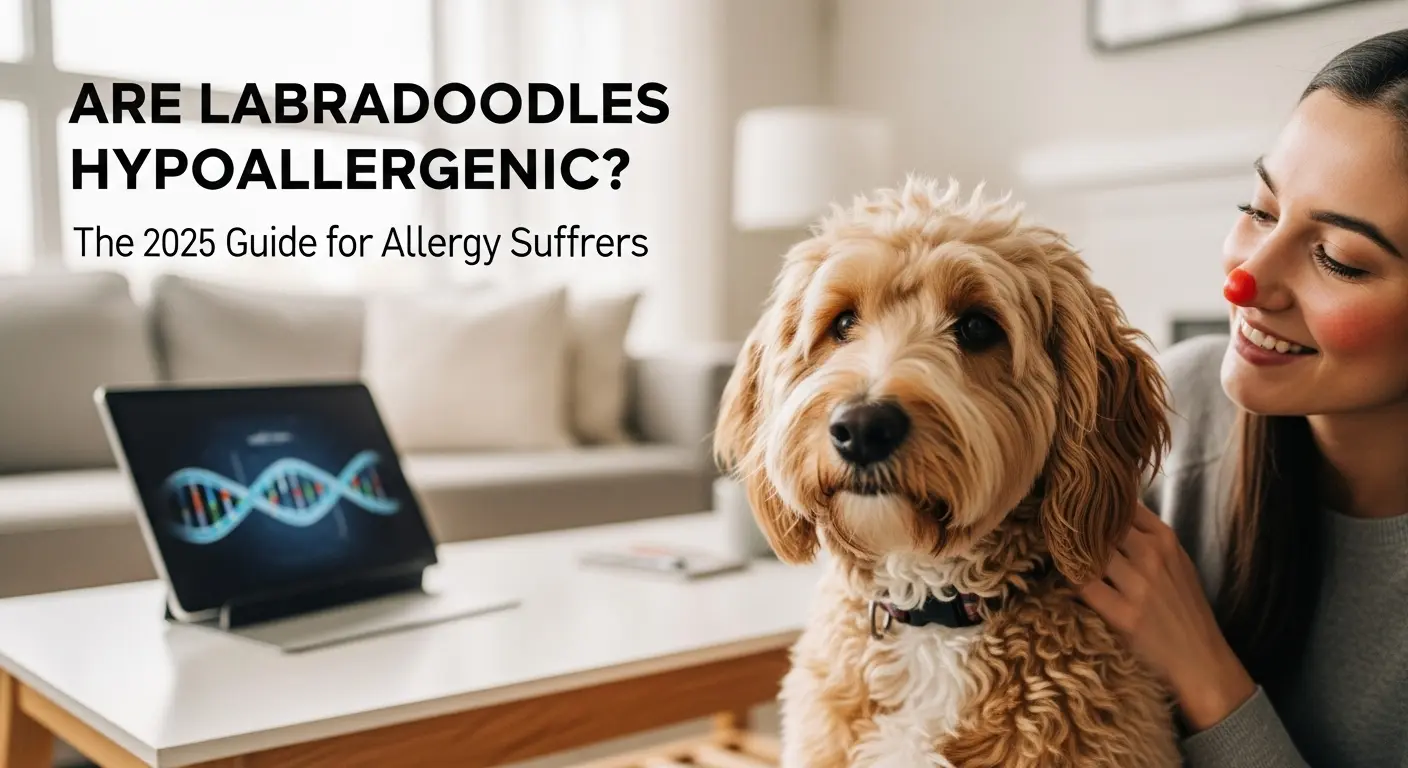Are Labradoodles Hypoallergenic? The 2025 Guide for Allergy Sufferers

Unpacking the Myth: What Does "Hypoallergenic" Actually Mean?
Let's be honest, the word "hypoallergenic" feels like a magic spell, doesn't it? For anyone who has ever sneezed at the mere sight of a dog, it whispers the promise of a furry friend without the watery eyes and endless sniffles. It’s the word that brings so much hope to dog-loving allergy sufferers.
But before we get carried away planning a future with a four-legged companion, it's time for a little heart-to-heart. Here’s the most important truth you need to know: there is no such thing as a 100% hypoallergenic dog.
It’s a shocking statement, I know! But the term is a bit of a marketing masterpiece. The real "allergy culprit" isn't the fur itself, but tiny proteins found in a dog's:
- Dander: Tiny, microscopic flecks of dead skin that every animal (and human!) sheds.
- Saliva: When your dog lovingly licks you (or their own fur), they leave behind proteins that can trigger allergies.
- Urine: This also contains the same problematic proteins.
When people say they are allergic to dogs, they are actually having an immune reaction to one or more of these specific proteins.
So, if all dogs produce these allergens, how can any dog be considered "hypoallergenic"?
The secret lies in the delivery system. Think of a dog's coat as the vehicle that spreads these allergens around your home. A heavy-shedding dog is like a fan, constantly blowing dander and dried saliva-covered fur into the air, onto your couch, and all over your clothes.
A low-shedding dog, on the other hand, has a coat that traps these allergens. The dander and saliva stay close to the dog's skin instead of becoming airborne.
So, when we talk about a hypoallergenic dog, what we're really talking about is a low-allergen or allergy-friendly dog. It’s a dog breed that sheds very little, therefore releasing significantly fewer allergens into your environment.
Now that we’ve cleared the air (pun intended!), we can look at why Labradoodles have earned such a stellar reputation in the allergy-friendly world. It's all about their brilliant genetic makeup.

The Poodle Influence: Why Labradoodles Are an Allergy-Friendly Choice
So, if the real issue is how allergens are spread, what’s the secret ingredient in the Labradoodle’s recipe for an allergy-friendly dog? In one word: Poodle.
The Poodle is the unsung hero for allergy sufferers everywhere. Their inclusion in the Labradoodle mix isn't just for their incredible intelligence or stylish looks; it's almost entirely because of their unique, low-shedding coat. This isn't an accident—the original goal of the Labradoodle was to create a guide dog for a woman whose husband was allergic.
Let's break down what makes the Poodle coat so special:
The Poodle Coat: A Game-Changer for Allergies
Unlike their Labrador Retriever parent, who has a thick, double-layered coat designed to shed water (and fur!), Poodles have a single layer of dense, curly hair. This structure is the key to their allergy-friendly status.
- It’s Hair, Not Fur: The texture is more like human hair. It grows continuously and sheds very, very little. Less shedding means less dander and dried saliva being released into your home.
- The Curls Act as a Trap: Imagine their tight, curly coat as a natural 'dander trap.' Instead of shedding loose hair and skin flakes all over your furniture, the Poodle's coat cleverly holds onto it. This trapped dander is then removed during regular grooming and brushing, rather than floating freely in the air you breathe.
Creating the Best of Both Worlds
The genius of the Labradoodle was to combine the famously friendly, easy-going temperament of the Labrador with the low-shedding, allergy-friendly coat of the Poodle. The hope was to get a dog that was both a perfect family companion and a manageable partner for those with allergies.
However, genetics can be a bit of a lottery. Mixing a heavy-shedder with a non-shedder doesn't always result in a perfect, non-shedding puppy. This is where understanding the different types of Labradoodle coats and generations becomes absolutely crucial.

Not All Doodles Are Created Equal: Coat Types and Generations Matter
If you're starting to think that choosing a Labradoodle is a bit more complex than just picking the cutest puppy, you're absolutely right! This is where we get into the heart of the matter. The "hypoallergenic" quality of a Labradoodle isn't guaranteed—it's heavily influenced by its genetics.
Think of it as a genetic lottery. To understand your odds, you need to get familiar with two key concepts: generations and coat types.
Understanding Labradoodle Generations (The "F" System)
You'll often see terms like F1, F1B, or Multigen. This isn't just breeder jargon; it's your roadmap to finding a low-shedding companion.
-
F1 Labradoodle: This is the first generation, a direct cross between a purebred Labrador Retriever and a purebred Poodle. Genetically, they are 50/50. The catch? Their coats are highly unpredictable. Some may get the Poodle's curly, low-shedding coat, while others might inherit the Labrador's shedding coat. An F1 is a wonderful dog, but it's the biggest gamble for an allergy sufferer.
-
F1B Labradoodle: This is where the odds tip in your favor. An F1B is a cross between an F1 Labradoodle and a purebred Poodle. The 'B' stands for 'backcross.' This makes the puppy approximately 75% Poodle and 25% Labrador. With that much Poodle genetics, these dogs are far more likely to have a non-shedding, allergy-friendly coat. For most allergy sufferers, the F1B is the gold standard.
-
Multigenerational (Multigen) Labradoodles: These are doodles bred from two Labradoodle parents (for example, two F1Bs bred together). By this stage, reputable breeders are focusing on solidifying the most desirable traits, including a consistently non-shedding coat. Multigen Labradoodles are often the safest bet for those with severe allergies.
The Three Main Labradoodle Coat Types
The generation directly influences the type of coat a puppy will have. Here’s what to look for:
-
Hair Coat: This coat is straight or slightly wavy and feels more like the fur on a Labrador. It's the most likely to shed and is generally not recommended for people with allergies. This coat is most common in F1 Labradoodles.
-
Fleece Coat: This is the coat many people picture! It's incredibly soft, with a silky texture that can be either wavy or lightly curled. It feels like a beautiful angora blanket. The fleece coat is considered very low-shedding and is an excellent choice for allergy sufferers.
-
Wool Coat: This coat is dense, curly, and feels very much like a Poodle's coat (think of a little lamb!). It's the most allergy-friendly and non-shedding coat type you can get. The only downside is that its tight curls require diligent grooming to prevent matting.
Understanding these differences is your superpower. It empowers you to ask a breeder the right questions and choose a dog whose coat is perfectly suited for your home and your health.
Tips for Living with a Labradoodle When You Have Allergies
So, you’ve done your homework. You understand the science, you know which generation and coat type to look for, and you're ready to take the leap. Congratulations! Choosing the right Labradoodle is half the battle, but managing your home environment is the other half.
Even with the most allergy-friendly Labradoodle, you're still living with an animal that produces some dander. The goal now is to create a happy, healthy home for both you and your new best friend. These proactive steps can make all the difference.
1. Grooming is Your Best Friend
This is non-negotiable. A well-groomed Labradoodle is a low-allergen Labradoodle.
- Brush Regularly: Aim to brush your Doodle at least 3-4 times a week, preferably outside. This removes the trapped dander and loose hair before it has a chance to escape into your home. Think of it as controlled shedding.
- Professional Grooming: Schedule a professional grooming appointment every 6-8 weeks. A good groomer will give your dog a proper bath and haircut, which significantly reduces the overall allergen load.
- Bathing: You can bathe your dog at home between professional grooms, but don't overdo it. Bathing too frequently can dry out their skin, leading to more dander. Use a high-quality, gentle dog shampoo.
2. Create Allergy-Safe Zones
Your home is your sanctuary, and it's okay to set some boundaries.
- The Bedroom is Off-Limits: This is the most important rule. You spend a third of your life sleeping, and your body needs that time to rest and recover without being exposed to allergens. Keeping the dog out of the bedroom can be a game-changer.
- Invest in HEPA Filters: High-Efficiency Particulate Air (HEPA) filters are your secret weapon. Use them in your vacuum cleaner and in standalone air purifiers, especially in the rooms where you and your dog spend the most time (like the living room).
- Wash Everything Frequently: Wash your dog's bed, blankets, and soft toys in hot water at least once a week. You should also wash your own bedding, curtains, and throw pillows regularly.
3. Before You Make the Final Commitment
This is the most crucial piece of advice.
- Spend Time with Your Puppy: Before bringing a puppy home, arrange to spend at least an hour with it at the breeder's home. See how you feel during and after the interaction. Better yet, spend time with the puppy's parents, as they'll give you a good idea of the coat type.
- The T-Shirt Test: Ask the breeder if you can leave a clean t-shirt with the puppy for a night. The next day, pick it up and see how you react to it. It’s a simple, low-risk way to test your specific sensitivity to that particular dog's dander.
Living with a dog when you have allergies requires a little extra work, but for the love and joy a Labradoodle brings, it's a small price to pay. With the right dog and the right habits, you can absolutely make your dream of dog ownership a sneeze-free reality.